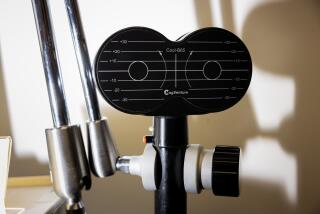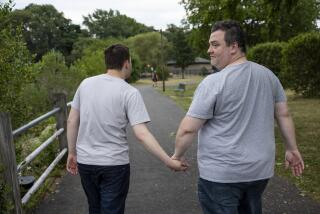Evidence Linking Defect in Brain to Autism Discovered
- Share via
SAN DIEGO — Researchers here say they have found the most compelling evidence yet that a brain defect may be at least partially responsible for autism, the mysterious disorder that locks one in 2,500 people in the United States inside a prison of the brain’s own making.
The defect is the underdevelopment of a portion of the cerebellum, deep inside the brain, researchers from Children’s Hospital and UC San Diego Medical Center report in today’s issue of the New England Journal of Medicine.
The fist-sized cerebellum regulates motor activity and also helps the body pay attention to or ignore stimuli--suggesting how the defect might result in the abnormal behaviors seen in autism. These include extreme inattention, hypersensitivity to sound or other stimuli and repetitive motions such as rocking. The disorder, which seems to run in families, affects an estimated 300,000 to 500,000 people in the United States, only 1% to 2% of whom ever can learn to live independently.
Though preliminary, the finding represents a “very interesting” step toward identifying autism’s causes and making it easier to diagnose, said Dr. Edward R. Ritvo, a leading autism researcher at the UCLA School of Medicine.
Ritvo emphasized, however, that the San Diego study was on too small a number of patients to be considered definitive. In addition, it would point toward a cause for only a single type of autism, and scientists believe they eventually will find that there are several different types, he noted.
A New England Journal of Medicine editorial that accompanied the research report agreed.
“It is likely that a variety of (brain-damaging factors) act through one or more mechanisms to produce the final behavioral syndrome,” wrote Drs. Fred R. Volkmar and Donald J. Cohen of Yale University. “. . . The generalizability of the finding to larger, and more representative, population samples will be of considerable interest.”
Smaller Brain Structure
Using magnetic resonance images, the San Diego researchers found that tiny sections of a two-inch structure in the middle of the cerebellum, called the vermis, was 25% smaller than normal in 14 of their 18 subjects than in non-autistic people.
Magnetic resonance imaging uses an intense magnetic field to reorient atoms in the body and construct computerized pictures of it based on the pattern in which the atoms return to their normal magnetic state.
“Like any part of the brain, this part of the brain begins very, very small and gradually grows larger. What we are seeing is . . . that the brain stopped growing,” said Eric Courchesne, director of the neuropsychology research laboratory at San Diego’s Children’s Hospital and leader of the research team.
The magnetic images indicate that the brain failed to grow normally during development of the fetus, not after birth, Courchesne said. The most likely time appears to be the end of the first trimester of pregnancy or during the second trimester, he said.
“It’s kind of like a tree that instead of growing to its full size remains small, as compared to a tree that grew full size.” he said.
This finding is important, he said, because previous attempts to find physical cause in the brain for autism were done with patients whose brain damage might have resulted from the mental retardation or seizures from which they also suffered. None of the 18 of the San Diego patients had either condition.
Courchesne said he is not concerned that four of the 18 patients in the study did not show cerebellar abnormalities.
‘Large Portion of Autism’
“It’s very clear that this does not necessarily occur in all autistic people, but if you add together (previous) evidence plus our evidence, it’s clear that it does occur in a very large portion of autism,” Courchesne said. “We’re at a point for the first time where we can see a consistent of developmental abnormality in the nervous system of a large number of autistic people.”
Even if the brain abnormality does not ultimately prove to be a cause of autism, it might serve as a “marker” suggesting other areas of the brain--which are formed at the same embryonic stage--where an autism cause might lie, said Dr. Arnold Cohen, assistant professor of clinical psychiatry at Mt. Sinai Medical Center in New York.
The San Diego team consisted of Courchesne, who also is an associate professor of neurosciences at UC San Diego; Rachel Yeung-Courchesne, manager of the Children’s Hospital neuropsychology research lab; Dr. Gary Press and Dr. John R. Hesselink of the UC San Diego Magnetic Resonance Institute, and Terry Jernigan, assistant professor of neurosciences at UC San Diego.
Collection of Neurons
The C-shaped vermis sits in the middle of the cerebellum, which is beneath the brain’s much larger central portion, the cortex. Two portions of the vermis--a collection of neurons--were studied to see their size relative to the rest of the vermis.
In autistic patients, the two portions averaged 232 square millimeters in size, compared to 305 square millimeters in normal subjects, the report said.
Recent magnetic resonance scans by Dr. H. Jordan Garber and Ritvo at UCLA failed to confirm this pattern but that may have been because the UCLA study did not use the same measurement technique, Ritvo said. The UCLA team will reanalyze their scans using the now-published method, he said.
Other groups around the country are also working to test the San Diego researchers’ findings.






